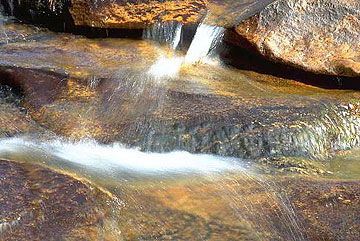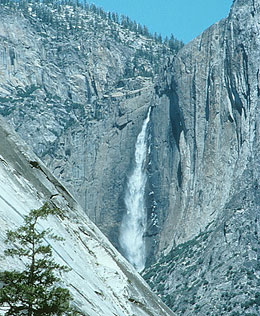Salinity Management Guide

Water, an agent of weathering
Fundamentals
Sources of salt-related ions in water
All irrigation waters contain at least small amounts of dissolved mineral salts. Where does the salt come from?
Salt in natural waters
Any mineral exposed at Earth's surface may decompose, and its matter may become dissolved in water by a process known as weathering. One of the principal agents of weathering is water itself.
One way water does this kind of work is by freezing and then melting again, over and over. When that happens within cracks or other voids in a rock, the rock eventually may be split apart. Over a long time, such action can reduce rocks into smaller and smaller fragments.

Upper Yosemite Falls, carrying dissolved matter toward the ocean
Another way water does this kind of work is by reacting chemically with a rock's mineral matter, possibly eventually altering or replacing those minerals.
So, during the process of weathering, water exerts an influence on the geologic materials. The net result is that rocks are broken down finer and finer and, where water is present, minerals may become dissolved.
The minerals and rocks that break down during weathering also affect the water that acts on them. Thus, the very act of dissolving imparts to nearby water a mineral content that is at least a little bit different than previously existed at that location.
Though weathering wears rocks away over geologic time, matter is not destroyed. What was once solid rock becomes fine sediment and colorless, dissolved mineral matter. In some places, residual or "secondary" minerals, principally clays, form during weathering. Eventually, all these materials are carried by streams and rivers to the ocean.
| « Previous page | Next page » |